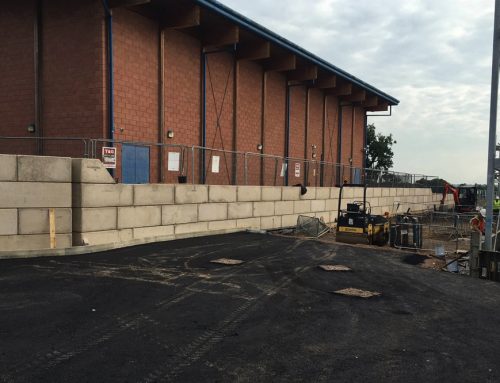In previous blogs, we’ve covered the benefits of Concrete Lego Blocks, things to consider before purchasing them and why you should be using them, however one aspect we haven’t covered yet is about how the blocks should be unloaded, moved and fitted. In response, we’ve put together this quick tip sheet for anyone considering investing in our Concrete Lego Block solution.
Before Purchasing
We always ask potential customers to provide us with exact dimensions/measurements of the walls they’re fitting so we can provide them with drawings of how the walls will look. This also enables us to know exactly how many blocks will be needed. Some customers are happy with rough estimates if they are just in the process of getting approximate prices however for some, exact measurements are crucial in determining the correct costings. We’ll always then send over the drawing with costings to the customer to review and feedback. This is crucial as it enables us to set customers’ expectations and provide the exact amount of concrete they will need for the walls.
Flat Ground
The next question we generally ask is about the ground the blocks will be laid on. Again this is crucial at the beginning of any project as the blocks interlock, so the ground needs to be perfectly flat.
This was a question that started cropping up more and more when we first started delivering blocks to sites, so to pre-empt this we put together a delivery and fitting guide, and this goes out to every customer when they have placed an order.
As a quick rule of thumb, foundations should be a concrete raft or slab, a concrete strip foundation, or a consolidated MOT type 1 stone foundation built flat and to a tolerance of around 5mm
Delivery
There are 3 different transportation methods we use here at Blockwalls. We either deliver blocks using a Hiab truck so the blocks can be lifted off by our driver, a flat deck truck, which requires the customer to have the means to unload the blocks or a curtain sided truck which again requires the customer to unload the vehicle. We have discussions with all our customers prior to delivery to ensure a smooth transition. Most customers will have the means in which to unload and lay the blocks themselves however we do provide full instructions on how to do this.
Lifting Clutches
All our blocks are fitted with a casting bar which is cast into the block during manufacture, this enables customers who have the correct machinery on site in the form of either a forklift truck or Telehandler to attach a lifting clutch to their machinery which can be purchased from ourselves. The lifting clutch attaches to the bar cast into the block, which in turn enables them to lift and place the blocks effortlessly into their final position and just makes the whole process much easier.
Alternatives to this method include a block grab attached to a forklift, these are relatively inexpensive to hire from a local tool hire specialist, or chains attached to the machinery to lift and move the blocks into place.
Laying the Blocks
If all of the above has been followed, then you’re in a good position to start laying the blocks onto your base. The importance of getting the measurements correct at the beginning of this entire process is now more significant than at any other point. Ordered the correct quantity and sizes of blocks and bingo! However, if the walls haven’t been measured and reviewed correctly at the start of the process then we could be in trouble. The process in which the blocks should be laid out on your base is covered in our delivery and fitting guide however it isn’t rocket science and if you have the correct machinery on site then the blocks can be laid with minimum fuss.
If you are considering a Concrete Lego Block solution for your site or perhaps a retaining wall or Segregation bays, please feel free to contact us on 0800 880 3135
















